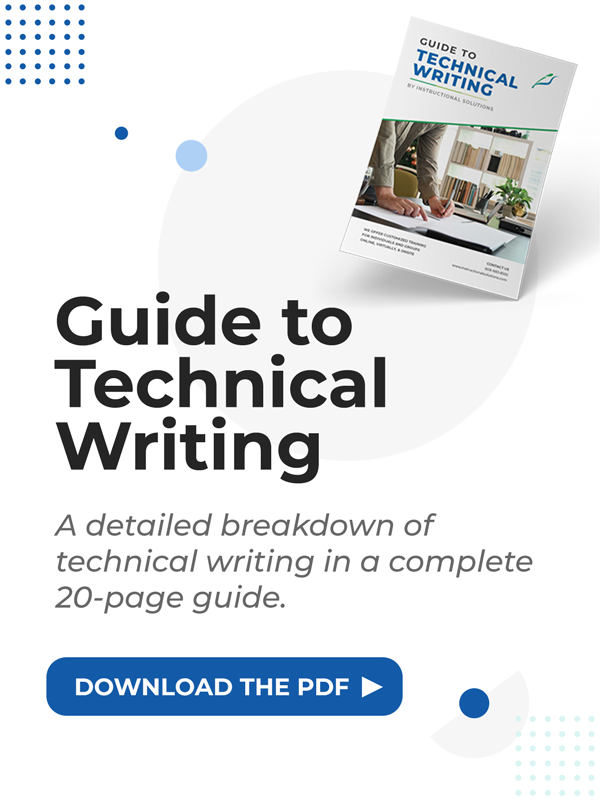5 Technical Writing Skills Teams Need to Hone

Originally published March 30, 2022, updated August 16, 2023

Table of Contents
Table of Contents
Technical writing, like business writing, is a broad category with a lot of nuances. Technical writing, obviously, transmits technical information. Typically, technical writing is less varied than business writing and the tone is more neutral.
Here are a few examples of technical documentation:
- User guides
- Technical reports
- Technical manuals/user manuals
- Software documentation
- Instructional documents
- Technical product descriptions
View the differences between business and technical writing here.
That said, most business writers will convey technical content at some point in their business writing, so here are five technical writing skills that all teams should hone.
Get written and live feedback on your actual technical writing in our Technical Report Writing course.
View the Full Course OutlineCompetent, neutral tone
The goal of technical writing is to clearly and effectively explain something, so the tone should be competent, neutral, and professional. Say things clearly and directly, with authority, to convey professionalism and competence.
Keep your writing as objective and neutral as possible to convey technical knowledge and information impartially. This is true no matter what type of document you are writing. Manuals, specs lists, reports, or emails that convey technical information require the technical writing skill of a competent, neutral tone in order to be clear, effective, and authoritative.
Prioritize clarity over sophistication
Part of a professional business tone is ensuring that clarity, not sophistication, is the goal. We always remind our clients to “write to express.” Simple language is often more effective.
Here are some key facets of this technical writing skill:
- Never use a long word when a shorter word will suffice.
- Use the verb form of a word (exemplify) instead of the noun form smothered in a phrase (make an example).
- Use strong business verbs (slinked) instead of weaker verbs (walked slowly, eyes averted) that need a modifier such as adverbs and unnecessary adjectives.
- Write simple sentences that put what needs to be done before why it needs to be done. (“Sell all investments in Sector X because demand is expected to fall,” is more clear and direct than “Because demand is expected to fall, sell all investments in sector X.”)
Keep your audience in mind
All business documents should be reader-focused. However, it is particularly important to hone the technical writing skill of audience analysis because the content can be highly specific and nuanced. What makes it more complicated is that technical communications are often written to non-technical audiences, so the subject matter has to be accessible.
A procedures list may be distributed to everyone in an organization. In this case, who are the employees? What is their knowledge level about the requirements of the procedures? In order to make the information accessible to all intended audience members and improve the user experience, you have to find the lowest common denominator and write for that.
Here’s another example. Instructions could be available to anyone who might buy a product. So, the instructions MUST be accessible to all potential customers. This is why IKEA uses images in its building instructions.
Clearly define and analyze your target audience, then develop your content for the person with the least understanding of the topic. This will make sure you meet the needs of all of your readers.
Read more: The Top Business Communication Skill You Need to Succeed
Use the passive voice judiciously
Let’s review the active and passive voice quickly. Here are my favorite active and passive voice examples:
The mouse ate the cheese. This sentence is in the active voice. Notice that the subject of the sentence is doing the action (i.e. the mouse is doing the eating).
The cheese was eaten by the mouse. This sentence is passive voice. Notice that the subject is receiving the action (the cheese is NOT doing the eating, but is being eaten).
The passive voice is not preferred in most business writing. But, it can be necessary and appropriate when conveying scientific or technical information, which often focuses on the result of an action and describes processes. Here are two examples that are common when conveying technical information:
- A cure for cancer has been found. The deal has been finalized.
These passive sentences focus on the result of an action rather than the person who did the action. - First, the data is entered into a table. Then, the data is analyzed for patterns. Finally, the data is presented with an appropriate graphical representation.
These sentences use the passive voice to describe a process.
In both of the examples above, the person doing the action is unknown or unimportant, so the passive voice is used to avoid awkward sentence construction. This is common when conveying technical information, so appropriate use of the passive voice is one of the key technical writing skills ALL teams need to hone. For more information on the appropriate use of the passive voice and active voice, see this blog post.
Use lists effectively
Almost all technical writing involves lists. One of the most important technical writing skills would be effective listing. Here are some key points (in list form no less!):
- Use bullets if the lists are non-sequential. This would make sense in policies.
- Use a numbered list when the information is sequential. This would make sense for specifications, instructions, job aids, and many other types of technical writing.
- Keep each bullet or number to ONE step or task. Do not combine steps or policies into a bullet or number
Ex. 1. Locate the power button. 2. Turn on the computer by pressing this button. 3. Choose the correct user. 4. Login with the corresponding password. - Use consistent and correct punctuation. Full sentences need to end with a period, and phrases do not. Punctuating bullet lists can be confusing! This article will provide detailed information on properly punctuating bullet lists.
- Make sure you use consistent, parallel structure and length, when possible. Parallel structure means keeping the syntax of each bullet the same. For example, each bullet in a list starts with a verb and is a command (Use, Keep, Make).
See this blog post for more information on better bullet point lists.
Learn a better process for technical writing and spend 25% less time on any complex document.
Receive individual written and live feedback in this practicum course.
Download the Course OutlineTechnical writing skills are not just for technical writers. At some point, most business writers need to convey technical information in an email, report, or executive summary. The five technical skills outlined above will help any business writer convey information effectively and efficiently in a technical document. Consistently follow a specific writing process to improve your overall writing skills.
Interested in learning more about technical writing and receiving expert written feedback and live coaching on your technical documents? Become a strong tech writer by taking our Technical Writing Course!




